NIOSH Noise: A 50-Year Timeline of Research and Intervention
Posted on by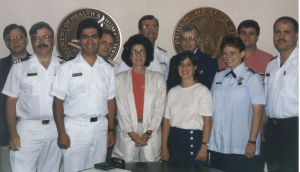
Noise is among the oldest occupational hazards. An 18th century report noted hearing loss among coppersmiths whose “ears are injured by that perpetual din” from hammering on metal.[1] In view of this, noise was among the first hazards NIOSH addressed when the Institute was established in 1971. A dedicated Noise Section was established in Cincinnati to conduct field studies of noise exposure, design engineering controls, test hearing protection devices, evaluate the effectiveness of hearing loss prevention programs, develop standards, and advise government and non-government entities on occupational noise-related policy.
Occupational hearing loss persists today across many industries and occupations. About 22 million workers are exposed to hazardous noise each year. Roughly 10 million workers are exposed to solvents and an unknown number are exposed to other chemicals that that are known to contribute to hearing loss. Twenty-four percent of the hearing difficulty among U.S. workers is due to workplace exposures.
As NIOSH celebrates its 50th anniversary, the NIOSH Hearing Loss Prevention Research Program looks back over 50 years of research and recommendations for preventing work-related hearing loss. Some early recommendations are still in place today. Others have been updated as new information and better technologies have become available. What remains constant throughout is our mission “to provide national and world leadership to reduce the prevalence of occupational hearing loss.”
1972: Noise Criteria Document
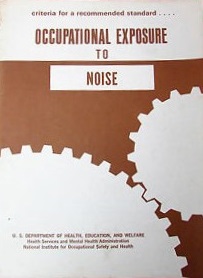 The 1970 Occupational Safety and Health Act charged the newly created NIOSH with recommending occupational safety and health standards that establish safe exposure levels for workers. NIOSH publishes criteria documents to address this mandate. The original NIOSH noise criteria document was among the first five recommendations published by the Institute, attesting to the high prevalence of noise hazards and the importance of interventions to prevent hearing loss. The criteria document established a Recommended Exposure Limit (REL) for noise of 85 decibels, A-weighted (dBA) as an 8-hour time-weighted average (TWA) for new installations, with a 5-dB exchange rate (i.e., halving allowable exposure time for every 5 dB increase in noise level). The document allowed a temporary 90 dB(A) REL for existing noisy worksites to allow time for implementation of engineering controls. This criteria document was updated in 1998.
The 1970 Occupational Safety and Health Act charged the newly created NIOSH with recommending occupational safety and health standards that establish safe exposure levels for workers. NIOSH publishes criteria documents to address this mandate. The original NIOSH noise criteria document was among the first five recommendations published by the Institute, attesting to the high prevalence of noise hazards and the importance of interventions to prevent hearing loss. The criteria document established a Recommended Exposure Limit (REL) for noise of 85 decibels, A-weighted (dBA) as an 8-hour time-weighted average (TWA) for new installations, with a 5-dB exchange rate (i.e., halving allowable exposure time for every 5 dB increase in noise level). The document allowed a temporary 90 dB(A) REL for existing noisy worksites to allow time for implementation of engineering controls. This criteria document was updated in 1998.
1975: Industrial Noise Control Manual
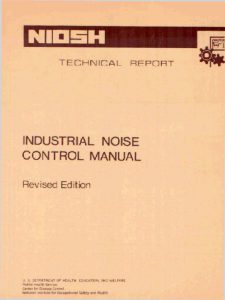 NIOSH advocates a hierarchy of controls to identify the best means of protecting workers from occupational hazards. Removing the hazard, substituting the hazard, or isolating workers from the hazard through engineering controls are the most effective approaches. In view of this, NIOSH published its first Industrial Noise Control Manual in 1975. The document included essential information about noise control techniques and a series of case histories illustrating the successful implementation of these techniques. The Industrial Noise Control Manual was updated and re-published in 1979. As the principles of noise control engineering have remained constant over time, much of the information in this manual is still relevant today. NIOSH is currently working on an update to its website that will include many of the noise control examples provided in this original publication.
NIOSH advocates a hierarchy of controls to identify the best means of protecting workers from occupational hazards. Removing the hazard, substituting the hazard, or isolating workers from the hazard through engineering controls are the most effective approaches. In view of this, NIOSH published its first Industrial Noise Control Manual in 1975. The document included essential information about noise control techniques and a series of case histories illustrating the successful implementation of these techniques. The Industrial Noise Control Manual was updated and re-published in 1979. As the principles of noise control engineering have remained constant over time, much of the information in this manual is still relevant today. NIOSH is currently working on an update to its website that will include many of the noise control examples provided in this original publication.
1975: Survey of Hearing Conservation Programs in Industry
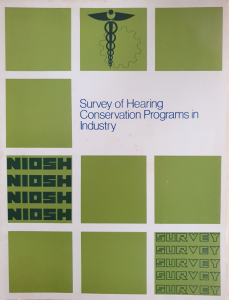 Shortly after publishing its criteria document on noise exposure, NIOSH conducted a survey of workplaces with hazardous noise exposures to assess successes and difficulties in reducing noise and implementing hearing conservation programs. The survey found that many companies struggled with reducing noise through engineering controls and pointed to the need for manufacturers to produce quieter equipment – a recommendation which eventually led to the establishment of the Buy Quiet initiative. The survey also found problems with audiometric testing programs; 80% of those visited failed to meet existing standards for audiometer calibration and/or background noise during testing. The need for better training for audiometric technicians led to NIOSH providing initial funding for development of a certification board for industrial hearing technicians through what is now known as the Council for Accreditation in Occupational Hearing Conservation (CAOHC).
Shortly after publishing its criteria document on noise exposure, NIOSH conducted a survey of workplaces with hazardous noise exposures to assess successes and difficulties in reducing noise and implementing hearing conservation programs. The survey found that many companies struggled with reducing noise through engineering controls and pointed to the need for manufacturers to produce quieter equipment – a recommendation which eventually led to the establishment of the Buy Quiet initiative. The survey also found problems with audiometric testing programs; 80% of those visited failed to meet existing standards for audiometer calibration and/or background noise during testing. The need for better training for audiometric technicians led to NIOSH providing initial funding for development of a certification board for industrial hearing technicians through what is now known as the Council for Accreditation in Occupational Hearing Conservation (CAOHC).
1976: Hearing Protector Compendium
Until engineering controls are implemented to reduce noise exposure to safe levels, hearing protection devices must be used to protect worker hearing. To assist employers in selecting appropriate hearing protection devices, NIOSH published its first Hearing Protector Device Compendium in 1976. Data on hearing protector attenuation and characteristics were collected from manufacturers and compiled with selection guidance into a single reference. The compendium was updated and re-released as a print document in 1984 and 1995 and then converted to an online resource in 2003. NIOSH has since discontinued updating the hearing protector compendium, as the most up-to-date information on individual hearing protection devices is now readily available from manufacturers’ websites.
1990: A Practical Guide to Effective Hearing Conservation Programs in the Workplace
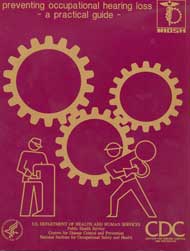 As the 20th anniversary of the Occupational Safety and Health Act and the publication of the original NIOSH noise criteria document drew near, it became evident that occupational hearing loss remained highly prevalent, even when companies were fully compliant with existing regulations. NIOSH therefore published “A Practical Guide to Effective Hearing Conservation Programs in the Workplace” to outline concepts and techniques that were associated with successful hearing loss prevention efforts. This non-technical guide provided recommendations for what management, hearing conservation program managers, and workers should do in order to successfully prevent work-related hearing loss. The guide was updated and republished as Preventing Occupational Hearing Loss – A Practical Guide in 1996.
As the 20th anniversary of the Occupational Safety and Health Act and the publication of the original NIOSH noise criteria document drew near, it became evident that occupational hearing loss remained highly prevalent, even when companies were fully compliant with existing regulations. NIOSH therefore published “A Practical Guide to Effective Hearing Conservation Programs in the Workplace” to outline concepts and techniques that were associated with successful hearing loss prevention efforts. This non-technical guide provided recommendations for what management, hearing conservation program managers, and workers should do in order to successfully prevent work-related hearing loss. The guide was updated and republished as Preventing Occupational Hearing Loss – A Practical Guide in 1996.
1998: Revised Noise Criteria Document
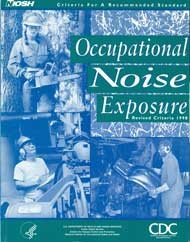 As new data on noise and its effects became available, NIOSH found it necessary to update its original noise criteria document in 1998. The revised Criteria for a Recommended Standard: Occupational Noise Exposure maintained the Recommended Exposure Limit (REL) of 85 dBA as an 8-hr TWA from the original document. However, the revised criteria document recommended using a 3-dB exchange rate instead of 5-dB for calculating worker exposure, as supported by national and international consensus. The document also recommended an improved criterion for identifying shifts in worker hearing, rescinded its earlier recommendations regarding age correction, and proposed an alternative approach for de-rating hearing protector Noise Reduction Ratings to better reflect average real-world performance.
As new data on noise and its effects became available, NIOSH found it necessary to update its original noise criteria document in 1998. The revised Criteria for a Recommended Standard: Occupational Noise Exposure maintained the Recommended Exposure Limit (REL) of 85 dBA as an 8-hr TWA from the original document. However, the revised criteria document recommended using a 3-dB exchange rate instead of 5-dB for calculating worker exposure, as supported by national and international consensus. The document also recommended an improved criterion for identifying shifts in worker hearing, rescinded its earlier recommendations regarding age correction, and proposed an alternative approach for de-rating hearing protector Noise Reduction Ratings to better reflect average real-world performance.
2007+: Safe·In·Sound Awards
 Recognizing that many organizations have developed unique and successful approaches to preventing occupational hearing loss, NIOSH partnered with the National Hearing Conservation Association (NHCA) to create the Safe-In-Sound Award™. The annual award is given to individuals or organizations that document measurable achievements in hearing loss prevention. Examples from award winners are published and shared to help others identify new avenues to pursue in their own hearing loss prevention efforts. In addition, the award has facilitated the extension of successful hearing loss prevention strategies for noise exposures encountered in settings other than typical industrial workplace hearing loss prevention programs (e.g., musicians, hunters, military personnel). In 2018, the Safe-In-Sound Award™ partnership was extended to include the Council for Accreditation in Occupational Hearing Conservation.
Recognizing that many organizations have developed unique and successful approaches to preventing occupational hearing loss, NIOSH partnered with the National Hearing Conservation Association (NHCA) to create the Safe-In-Sound Award™. The annual award is given to individuals or organizations that document measurable achievements in hearing loss prevention. Examples from award winners are published and shared to help others identify new avenues to pursue in their own hearing loss prevention efforts. In addition, the award has facilitated the extension of successful hearing loss prevention strategies for noise exposures encountered in settings other than typical industrial workplace hearing loss prevention programs (e.g., musicians, hunters, military personnel). In 2018, the Safe-In-Sound Award™ partnership was extended to include the Council for Accreditation in Occupational Hearing Conservation.
2008+: NIOSH Science Blogs and Social Media Outreach
With the advent of social media, the NIOSH Hearing Loss Prevention Research Program has embraced these new opportunities to share information about preventing noise-induced hearing loss. A series of NIOSH Science Blog posts linking to popular events such as the World Cup, NASCAR, and the cicada emergence have helped raise awareness about hearing loss prevention. Other blogs have provided practical, user-friendly information on topics such as choosing the right hearing protector or measuring impulse noise. You can find all the NIOSH hearing-related blogs here. The NIOSH Hearing Loss Prevention Team won the National Hearing Conservation Association Media Award in 2011 for its series of NIOSH Science Blog postings, including three focused on the entertainment and sports industries. In 2021, the team was recognized with the NHCA Media Award again as part of the CDC Working Group on Noise-Induced Hearing Loss. In addition to the NIOSH Science Blog, the noise group maintains a Twitter account – @NIOSHNoise.
2009+: Occupational Hearing Loss (OHL) Surveillance Program
 NIOSH has long recognized the need for surveillance data in order to effectively prevent work-related hearing loss. The 1988 “Proposed National Strategy for the Prevention of Noise-Induced Hearing Loss” recommended analyzing audiometric data collected for regulatory compliance as one means of collecting such surveillance data. In 2009, this recommendation took shape as NIOSH established the OHL Surveillance Program. The Program partners with hearing test service providers to collect de-identified hearing tests from noise-exposed workers. This approach has allowed NIOSH to collect millions of hearing tests from thousands of U.S. workplaces for surveillance and research. Using these and other data, the Program has published many statistics by industry and occupation, in addition to trends over time.
NIOSH has long recognized the need for surveillance data in order to effectively prevent work-related hearing loss. The 1988 “Proposed National Strategy for the Prevention of Noise-Induced Hearing Loss” recommended analyzing audiometric data collected for regulatory compliance as one means of collecting such surveillance data. In 2009, this recommendation took shape as NIOSH established the OHL Surveillance Program. The Program partners with hearing test service providers to collect de-identified hearing tests from noise-exposed workers. This approach has allowed NIOSH to collect millions of hearing tests from thousands of U.S. workplaces for surveillance and research. Using these and other data, the Program has published many statistics by industry and occupation, in addition to trends over time.
2010+: Workplace Solutions Series
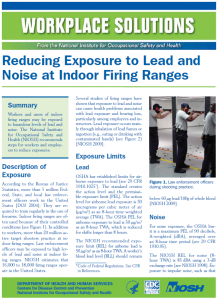 NIOSH Workplace Solutions translate NIOSH research into understandable, accessible, and easily implemented recommendations that can be readily used by occupational safety and health professionals. Over the past decade, the NIOSH Hearing Loss Prevention Research program has published a number of Workplace Solutions addressing indoor and outdoor firing ranges, call and dispatch center operators, firefighters, and musicians as well as project design and operation. NIOSH also introduced its Total Hearing Health concept through a Workplace Solutions publication. Based on the NIOSH Total Worker Health® approach, Total Hearing Health integrates prevention of work-related hearing loss with overall hearing health efforts to promote better hearing and reduce the risks associated with noise exposure. Workplace Solutions documents provide practical solutions to occupational noise problems.
NIOSH Workplace Solutions translate NIOSH research into understandable, accessible, and easily implemented recommendations that can be readily used by occupational safety and health professionals. Over the past decade, the NIOSH Hearing Loss Prevention Research program has published a number of Workplace Solutions addressing indoor and outdoor firing ranges, call and dispatch center operators, firefighters, and musicians as well as project design and operation. NIOSH also introduced its Total Hearing Health concept through a Workplace Solutions publication. Based on the NIOSH Total Worker Health® approach, Total Hearing Health integrates prevention of work-related hearing loss with overall hearing health efforts to promote better hearing and reduce the risks associated with noise exposure. Workplace Solutions documents provide practical solutions to occupational noise problems.
2011: Buy Quiet Initiative
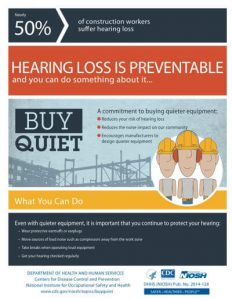 Consistent with the NIOSH Hierarchy of Controls, the NIOSH Buy Quiet Initiative encourages companies to reduce noise levels by purchasing quieter equipment. This can be accomplished when new businesses start up or when older equipment is replaced. Designing quieter equipment at the manufacturing stage fits the NIOSH Prevention through Design principle of eliminating hazards as early as possible in the life cycle of items or workplaces. NIOSH developed a set of educational materials and promotional tools to inform employees, management, customers, and the community about the importance and benefits of Buy Quiet. In addition, NIOSH has established partnerships with other national and international organizations which promote the Buy Quiet Initiative.
Consistent with the NIOSH Hierarchy of Controls, the NIOSH Buy Quiet Initiative encourages companies to reduce noise levels by purchasing quieter equipment. This can be accomplished when new businesses start up or when older equipment is replaced. Designing quieter equipment at the manufacturing stage fits the NIOSH Prevention through Design principle of eliminating hazards as early as possible in the life cycle of items or workplaces. NIOSH developed a set of educational materials and promotional tools to inform employees, management, customers, and the community about the importance and benefits of Buy Quiet. In addition, NIOSH has established partnerships with other national and international organizations which promote the Buy Quiet Initiative.
2017: NIOSH Sound Level Meter App
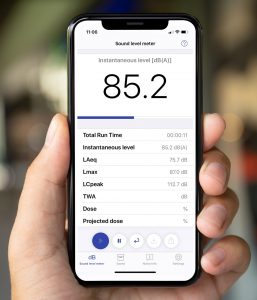 As noise measurement apps for smartphones became increasingly available, NIOSH researchers evaluated 192 sound measurement applications (apps) for the iOS and Android platforms to examine their suitability and accuracy in relation to professional sound measurement instruments (see blog). Realizing that most of the apps on the market were intended for the casual user and lacked the accuracy and functionality necessary to conduct occupational noise measurements, NIOSH hearing loss prevention researchers collaborated with an app developer to create an iOS-based sound level meter app that measures and characterizes occupational noise exposure similar to professional instruments. The NIOSH Sound Level Meter (NIOSH SLM) app for iOS devices is available for free on the App Store and can be used by the occupational safety and health community as well as the general public.
As noise measurement apps for smartphones became increasingly available, NIOSH researchers evaluated 192 sound measurement applications (apps) for the iOS and Android platforms to examine their suitability and accuracy in relation to professional sound measurement instruments (see blog). Realizing that most of the apps on the market were intended for the casual user and lacked the accuracy and functionality necessary to conduct occupational noise measurements, NIOSH hearing loss prevention researchers collaborated with an app developer to create an iOS-based sound level meter app that measures and characterizes occupational noise exposure similar to professional instruments. The NIOSH Sound Level Meter (NIOSH SLM) app for iOS devices is available for free on the App Store and can be used by the occupational safety and health community as well as the general public.
2018: Preventing Hearing Loss Caused by Chemical (Ototoxicity) and Noise Exposure
Early in its history, NIOSH efforts to prevent work-related hearing loss centered exclusively on noise as the exposure of concern. Over time, however, it became increasingly evident that some workplace chemicals can also damage hearing. Substances including certain pesticides, solvents, and pharmaceuticals that contain ototoxicants can negatively affect how the ear functions, causing hearing loss and/or affecting balance. The risk of hearing loss is increased when workers are exposed to these chemicals while working around elevated noise levels. In 2018, NIOSH and OSHA released a joint information bulletin Preventing Hearing Loss Caused by Chemical (Ototoxicity) and Noise Exposure. The document raised awareness of this issue, provided examples of ototoxic chemicals, listed the industries and occupations at risk and provided prevention information.
2019+: Wikipedia Campaigns
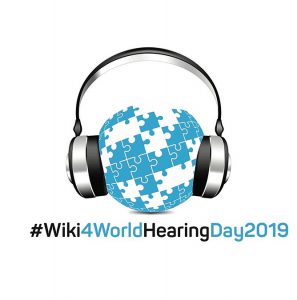 Wikipedia has become the “go to” site for millions of people looking for information on just about any topic. Accordingly, the NIOSH Hearing Loss Prevention Research team has harnessed the power of Wikipedia to provide information on noise and hearing loss. For World Hearing Day 2019, NIOSH took the lead in designing the online campaign Wiki4WorldHearingDay2019, with support from the World Health Organization, Cochrane, and several professional associations. The campaign aimed to expand and improve Wikipedia content related to hearing. The platform (translated into 15 languages) provided guidance and invited anyone with access to a computer and the internet to join (see related blog). In 2020, NIOSH and its partners undertook a similar year-long effort − Wiki4YearOfSound2020. During the year, more than 235,000 words were contributed to 1000 existing and 80 new Wikipedia articles, 929 references were added, and more than 2300 media files were donated to the open access repository Wiki Commons. The articles received more than 131 million views during the tracking period.
Wikipedia has become the “go to” site for millions of people looking for information on just about any topic. Accordingly, the NIOSH Hearing Loss Prevention Research team has harnessed the power of Wikipedia to provide information on noise and hearing loss. For World Hearing Day 2019, NIOSH took the lead in designing the online campaign Wiki4WorldHearingDay2019, with support from the World Health Organization, Cochrane, and several professional associations. The campaign aimed to expand and improve Wikipedia content related to hearing. The platform (translated into 15 languages) provided guidance and invited anyone with access to a computer and the internet to join (see related blog). In 2020, NIOSH and its partners undertook a similar year-long effort − Wiki4YearOfSound2020. During the year, more than 235,000 words were contributed to 1000 existing and 80 new Wikipedia articles, 929 references were added, and more than 2300 media files were donated to the open access repository Wiki Commons. The articles received more than 131 million views during the tracking period.
Moving Forward…
While rates of occupational hearing loss have decreased, noise remains a prevalent workplace hazard across many economic sectors in the US, and occupational hearing loss is a serious risk for many workers. In 2019, NIOSH published the National Occupational Research Agenda for Hearing Loss Prevention to outline the knowledge and actions most urgently needed to reduce the burden of work-related hearing loss. The agenda identifies 5 objectives aimed at providing a sound scientific basis for best practices in hearing loss prevention, developing effective, evidence-based educational interventions, widely implementing noise controls, enhancing audiometric monitoring, and improving occupational hearing loss surveillance. To address these objectives, NIOSH is considering updates to the noise criteria document, particularly in the area of impulsive noise evaluation, hearing protector fit-testing, and accounting for age effects in audiometric monitoring. A new effort to collect national data on worker ototoxic chemical exposures by industry and occupation is also being considered, which would help target interventions to workers who may be overlooked by current regulations. Hearing protector fit-testing is making it feasible to ensure that each individual worker is properly protected when noise controls cannot sufficiently reduce exposure. The NIOSH Hearing Loss Prevention Research team remains committed to its vision that, in the next decade, “every 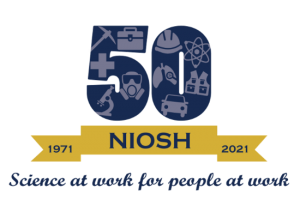 occupational noise exposed worker in the U.S. will be touched by NIOSH knowledge and technology.”
occupational noise exposed worker in the U.S. will be touched by NIOSH knowledge and technology.”
This blog is part of a series for the NIOSH 50th Anniversary. Stay up to date on how we’re celebrating NIOSH’s 50th Anniversary on our website.
Christa L. Themann, MA, CCC-A is a Research Audiologist in the NIOSH Division of Field Studies and Engineering.
Julie Tisdale-Pardi, MA, is the NIOSH Science Blog Coordinator.
CAPT Chucri (Chuck) A. Kardous, MS, PE, is a Captain with the United States Public Health Service and a research engineer with the NIOSH Division of Field Studies and Engineering.
Elizabeth A. Masterson, PhD, CPH, COHC, is a Co-Coordinator for the NIOSH Hearing Loss Prevention Cross-Sector Program and a Research Epidemiologist in the NIOSH Division of Field Studies and Engineering.
Thais C. Morata, PhD, is a Co-Coordinator for the NIOSH Hearing Loss Prevention Cross-Sector Program and a Research Audiologist in the NIOSH Division of Field Studies and Engineering.
CAPT William J. Murphy, Ph.D., is the former Coordinator for the NIOSH Hearing Loss Prevention Cross-Sector Program and a research physicist with the NIOSH Division of Field Studies and Engineering.
1Ramazzini B. 1713. De Morbis Artificum. Diseases of workers, translated from the Latin text by Wilmer Cave Wright, 1940. University of Chicago Press, Chicago, Illinois.
Posted on by

